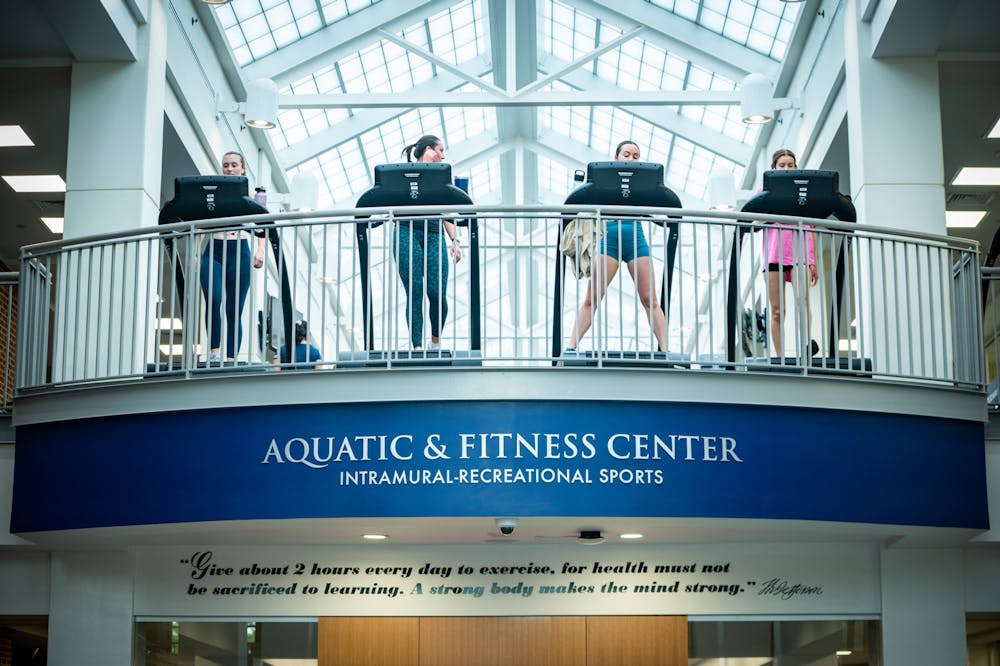When asked to describe a typical “gym bro,” students say they’re familiar with the type — a grunting, muscle tee-ed fitness guru with no shortage of creatine. But few say they actually see such characters on Grounds. Their descriptions of the University gym scene include friends, classmates, TAs and even professors simply focusing on one thing — their everyday health. Their prioritization of well-being, not just muscle gain or weight loss, raises the bar when it comes to gym culture on Grounds.
For student gym-goers, sustaining motivation to work out is a key step in building a healthy relationship with the gym. Second-year College student Isabella Paterson said working out gave her a sense of normalcy when coming to college. With four University gyms within reach, she said the gym is an accessible physical outlet, especially for students who want to keep moving after high school sports.
“When you come to college, there's so much more accessibility to gyms,” Paterson said. “I think it's one of those things where you come from a sport in high school [and] you don't want to do that sport anymore, but you still want to stay active.”
Some run into the challenge of working out consistently, though. Without a practice schedule or an arranged time to go to the gym, motivation to work out may slip away. To counter this problem, students turn to workout partners and friends to stay focused. According to third-year Engineering student Malik Kabra, surrounding yourself with others’ energy can help reinforce self-discipline.
“It's kind of holding yourself accountable — having someone there. It's like studying with your friends,” Kabra said. “I don't think I could work out consistently at home just because … there are other things that are attractive like my bed and the kitchen. So having a place where you can lift is super nice.”
While some find gym motivation through workout schedules and friends, others develop a consistent routine on their own. Third-year College student Taylor Roomsburg said tracking her progress is itself a driving force when lifting. For her, setting personal goals — and seeing herself achieve them — inspires her to keep working out.
“I love getting a new PR [and] just having something that I could work for,” Roomsburg said. “When I can get … a number that I can see, it really proves that my work is paying off.”
Students are not completely insulated from negative pressures to look or eat a certain way. Many gym influencers on social media cross the line from motivation into obsession, promoting unfounded diet tips and toxic gym practices. Amid these pressures, some students have felt the need to avoid social media accounts that depict unrealistic body standards.
“I feel like social media has a very skewed perception of what you can do in the gym. A lot of those people on social media are professionals, and you shouldn't compare yourself to them,” Paterson said. “You should go to the gym to make yourself feel good, not necessarily to look good.”
The University offers resources through Student Health and Wellness to counter potentially unhealthy attitudes toward working out. With support services related to physical strength, mental health and overall well-being, SHW encourages students to develop healthy relationships with their body.
Students have also found ways to stay active through Kinesiology classes offered in the School of Education and Human Development. In these one-credit, one-semester courses, students learn how to lift weights or play sports such as volleyball, squash, golf and basketball in a low-stakes environment. These classes resemble secondary school physical education without the embarrassment of running the FitnessGram Pacer Test in a baggy uniform. Roomsburg, who took a Kinesiology lifting class with a friend, said she enjoyed having scheduled, built-in time to work out during the week.
“It was super fun, [and] both of us had lifted before but it was good to just kind of have a routine with it,” Roomsburg said. “I definitely would be interested in doing some more [classes].”
According to Kabra, building relationships with other gym-goers — whether through classes or student groups — helps cultivate a sense of belonging. He said he was lifting at the Aquatic & Fitness Center during his first year when a fourth-year student came up to him and asked if he wanted to join a gym club at the University. He said this invitation made the on-Grounds gym community feel less daunting.
“If I go to some new [gym], it's always super intimidating because I don't know the people, and I feel more self-conscious about how I look or how I do things,” Kabra said. “But if you spend enough time there … you realize everybody's just there for a reason.”
Since then, Kabra has remained active through Virginia club pickleball and club baseball. These clubs, as well as other groups centered on physical activity — such as Virginia club powerlifting and the Barbell Club at U.Va. — support positive attitudes toward fitness on Grounds.
For these students, the most Herculean gym pursuits are less about achieving the build of a Greek god and more about building long-lasting, healthy relationships with the gym. Kabra said whenever he works out, he feels a sense of camaraderie among fellow gym-goers — a spirit that extends to anyone hoping to get involved in the University gym community.
“Everybody shares the same interest,” Kabra said. “People are just there to lift and vibe. If you go there with the same attitude, it’s going to be a good time.”







